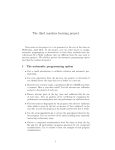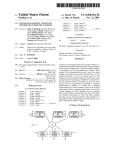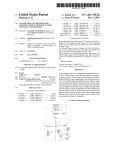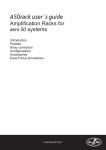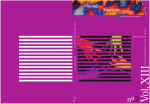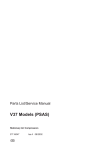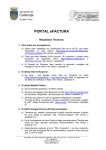Download Portable communication device having a fingerprint identification
Transcript
US006141436A United States Patent [19] [11] Patent Number: Srey et al. [45] [54] PORTABLE COMMUNICATION DEVICE HAVING A FINGERPRINT IDENTIFICATION SYSTEM [75] Inventors: Lena Srey, Chicago; Mark William Pod], Bartlett; Kevin D. Kaschke, Oct. 31, 2000 OTHER PUBLICATIONS StarTACTM90 Wearable Cellular Telephone User Manual, 1995, Motorola, Pan American Cellular Subscriber Group, 600 North US. Highway 45, Libertyville, Illinois 60048, pp. 2, 3 and 84—99 P . Hoffman Estates, all of Ill. Date of Patent: 6,141,436 E nmary . J L C xammer— Ose ' Ouso Assistant Examiner—ShaWn B. Cage Attorney, Agent, or Firm—Kevin D. Kaschke; Paul J. [73] Assignee: Motorola, Inc., Schaumburg, Ill. Barmsiak [57] ABSTRACT [21] APPL NO; 09/047,773 A portable communication . device (100, 300, 400, 500) [22] [51] 52 Flled? Mar- 25, 1998 Int Cl 7 G06K 9/00 607D 7/00 Us‘ Ci """""""""""""""" " 382/124? 340/825 34 a scanner (115) for scanning a ?ngerprint (123) of a ?nger (121) to generate an image of the ?ngerprint (123). In a ?rst embodiment, the scanner (115) is positioned relative to a [ I. . . ..................................... .. Fleld Of Search .................... ......... .. Switch (201) on the device (100, 300, 400, 500) to permit the ?nger to generate the actuation force for the Switch _ ] comprises a ?ngerpr1nt1dent1?cat1on system (709) including , . 382/127’ 380/23’ 30’ 340/825'3Al’ 825'69’ (201) When the ?ngerprint (123) is positioned on the scanner 825'72’ 348/552 (115). In a second embodiment, the scanner (115) is ergo nomically positioned on a housing (113, 117, 119) of the , [56] References C‘ted US PATENT DOCUMENTS device (100, 300, 400, 500) Where the ?nger (121) or a thumb naturally rests on the housing (113, 117, 119) When the person holds the housing (113, 117, 119) While the device ?llffay .................................... .. , , urray . . . . . 475777345 3/1986 Abramov 5 591 949 1/1997 Bernstein 58387306 11/1998 O’Connor 5,870,672 . . . . .. is in use‘ In a third embodiment, a - - transmitter (205) of the device (100, 300, 400, 500) trans mits data representative of the image of the ?ngerprint (123) to a remote site (715) When data representative of the image 2/1999 StOddard et al. ..................... .. 455/410 Ofthe ?ngerprint (123) does not mateh data representative of a reference ?ngerprint. FOREIGN PATENT DOCUMENTS 5-095329 _ 382/124 235/380 382/124 4/1993 Japan ............................. .. H04B 7/26 5 Claims, 7 Drawing Sheets U.S. Patent 0a. 31, 2000 Sheet 1 of7 FIG .1 6,141,436 U.S. Patent 0a. 31, 2000 Sheet 2 of7 6,141,436 11\5 SCANNER l I ’ l SWITCH 217 JR ‘ l77777/l/l/l/l/l/l/ /// /////!/1'~21,3 ‘ 119 PROCESSOR A203 CONNECTOR Z///////// /////////////// I// TRANSMITTER a . RECEIVER \205 I 207 211 FIG.2 209 215 U.S. Patent 0a. 31, 2000 Sheet 3 of7 6,141,436 U.S. Patent 0a. 31, 2000 Sheet 4 of7 6,141,436 N / / m U.S. Patent FIG.5 0a. 31, 2000 Sheet 5 of7 6,141,436 U.S. Patent 0a. 31, 2000 Sheet 6 of7 6,141,436 601 603 FINGER PRINT PRESENT 0N SCANNER 605 SCAN FINGER PRINT 60 7l STORE DATE REPRESENTING AN IMAGE OF THE SCANNED FINGER PRINT IN A FIRST NENORY DEVICE. DOES THE DATA REPRESENTING THE SCANNED FINGERPRINT INAGE HATCH DATA REPRESENTING A REFERENCE FINGERPRINT IMAGE STORED IN A SECOND MEMORY DEVICE ? 609 ENABLE CIRCUITRY IN THE DEVICE FOR NORMAL usa OF THE DEVICE I TURN ON A TRANSMITTER I 615\ SEND THE DATA REPRESENTING THE SCANNED FINGERPRINT INAGE AND THE LOCATION OF THE DEVICE TO A REMOTE SITE 6T7\ TURN OFF THE TRANSMITTER FIG.6 U.S. Patent 0a. 31, 2000 Sheet 7 of7 6,141,436 .. 53>E :25 EH?oz: 5 28 2:aMs2; azs:araga: 5xon9$235605m: a2s5: 2a5 2: > EN 52% A5285%:Q252 R 2mcit; 55:SNA rgw _ J$.r I|5 5: 2K U 2mgA.52 | l_ 5@28;: 555 “0E2:5 >55;tw l I l I I l l l l l l l l l l l I l I zsazzol 'h. RN N Q m2Eg meSN8“ 52m E5 6,141,436 1 2 PORTABLE COMMUNICATION DEVICE HAVING A FINGERPRINT IDENTIFICATION SYSTEM tems are knoWn in the art as exempli?ed by US. Pat. Nos. 5,473,144, 5,493,621, 5,546,471, 5,426,708, 5,465,303, 5,467,403, and 5,493,621 and by a ?ngerprint veri?er avail able from VLSI Vision Limited, 18805 Cox Avenue, Suite 260, Saratoga, Calif. 95070, USA. Fingerprint identi?cation FIELD OF THE INVENTION systems typically comprise a ?ngerprint scanner for scan The present invention generally relates to portable com ning a ?ngerprint, a read only memory (ROM) lookup table munication devices and more particularly to a portable for storing data representative of an authoriZed user’s communication device having a ?ngerprint identi?cation system. 10 ?ngerprint, a digital signal processor (DSP) having an algorithm for comparing the scanned ?ngerprint With the data representing an authoriZed user’s ?ngerprint. A ?nger BACKGROUND OF THE INVENTION print identi?cation system advantageously provides unique Portable communication devices, such as cellular telephones, are Well knoWn in the art and permit a user to personal user identi?cation. HoWever, ?ngerprint identi? cation system have not been applied to portable communi communicate With a remote site. Typically, a user pays a fee 15 cation devices. to a communications service provider for access to a com Accordingly, there is a need for a portable communication munication system in Which the portable communication device operates. Cellular telephones, in particular, have device having a ?ngerprint identi?cation system. BRIEF DESCRIPTION OF THE DRAWINGS become so popular that thieves have found it pro?table to steal these devices for their oWn use or for sale to another 20 user. To discourage the thieves and to generally provide elec present invention. tronic security, most cellular telephones permit a user to enter a code to electronically lock and/or unlock a cellular telephone. Electronically locking a cellular telephone pro FIG. 2 illustrates a cross-sectional vieW of a portion of a 25 hibits the cellular telephone from being used, such as to second embodiment the present invention. 30 FIG. 5 illustrates a perspective vieW of a portable com munication device in accordance With a third aspect of a Several knoWn techniques for generating an electronic 35 the cellular telephone labeled “FCN” (i.e. function) folloWed by pressing another key on the keypad of the cellular telephone labeled “5,” for example, pressing a predeter mined sequence of numerically labeled keys on a keypad of the cellular telephone, such as for example, by pressing the keys “5,” “3,” and “8,” and selecting a lock feature from a menu presented in an electronic display. One knoWn technique for generating an electronic unlock code include: pressing a predetermined sequence of numeri FIG. 6 illustrates a ?oWchart describing a method per 40 With a third embodiment the present invention. FIG. 7 illustrates an electrical block diagram a portable communication device in accordance With the ?rst, the second and the third embodiments the present invention. 45 The predetermined sequence of numerically labeled keys may be the same or different for electronically locking and 50 telephone to generate an electronic lock or an unlock code include: the electronic unlock and lock code may be used by someone other than the authoriZed user, if the electronic unlock and lock code is knoWn to the unauthoriZed user; second embodiment the present invention. formed by a portable communication device in accordance cally labeled keys on a keypad of the cellular telephone, such as for example, by pressing the keys “5,” “3,” and “8.” unlocking a cellular telephone. Disadvantages using keys on a keypad of the cellular FIG. 4 illustrates a perspective vieW of a portable com munication device in accordance With a second aspect of a second embodiment the present invention. phone. lock code include: pressing a key on a keypad of the cellular telephone labeled “LOCK,” pressing a key on a keypad of portable communication device of FIG. 1 in accordance With the ?rst embodiment the present invention. FIG. 3 illustrates a perspective vieW of a portable com munication device in accordance With a ?rst aspect of a make or receive telephone calls and/or to enable or disable particular features of the cellular telephone. Electronically unlocking a cellular telephone permits the cellular telephone to be used, such as to make or receive telephone calls and/or to enable or disable particular features of the cellular tele FIG. 1 illustrates a perspective vieW of a portable com munication device in accordance With a ?rst embodiment the 55 DETAILED DESCRIPTION OF THE PREFERRED EMBODIMENTS In FIGS. 1—7, like reference numbers represent the same element for feature. FIG. 1 illustrates a perspective vieW of a portable communication device 100 in accordance With a ?rst embodiment the present invention. FIG. 2 illustrates a cross-sectional vieW of a portion of a portable communica tion device 100 of FIG. 1 in accordance With the ?rst embodiment the present invention. The portable communi cation device 100 generally includes an earpiece transducer 101, a microphone transducer 103, a display 105, a keypad 107, an antenna 109, a volume sWitch 111, a battery housing needing to press the predetermined number of keys; needing 113, a ?ngerprint identi?cation system 709 (see FIG. 7) to remember the electronic unlock and lock code; needing to including a scanner 115, a front housing 117 and a rear conceal the pressing of the predetermined number of keys at appropriate times; needing to generate the electronic unlock and lock code before and after, respectively, the cellular housing 119. The design of portable communication device 100 including all of the elements mentioned hereinabove, With the exception of the ?ngerprint identi?cation system 60 telephone is used, such as to make or receive telephone calls and/or to enable or disable particular features of the cellular telephone; and needing to press one key to poWer on the 709 including a scanner 115, is Well knoWn in the art and is shoWn in US. Pat. No. Des. 384,952. The circuitry for the portable communication device 100 Will be discussed herein cellular phone folloWed by the predetermined number of keys to generate an electronic lock or an unlock code. Outside of the art of portable communication devices, such as cellular telephones, ?ngerprint identi?cation sys beloW With reference to FIG. 7. 65 The portable communication device 100 advantageously uses the ?ngerprint identi?cation system 709 including the scanner 115 as a substitute for the combination key press 6,141,436 3 4 sequence of the prior art to generate a lock code and/or an scanner 115. Therefore, the operation of the scanner 115 and the operation of the sWitch 201 are advantageously inte grated or combined to provide more ef?cient use of each unlock code for the portable communication device 100. The ?ngerprint identi?cation system advantageously provides unique personal identi?cation characteristic of a person’s ?ngerprint; Whereas, the combination key press sequence of the prior art provides a unique key press sequence. Disad vantages of the combination key press sequence of the prior operation, thereby simplifying the use of the portable com munication device 100. Referring to FIG. 2, the sWitch 201 is disposed underneath the scanner 115 to permit the scanner 115 to directly actuate art to generate a lock code and/or an unlock code include: the electronic unlock and lock code may be used by someone other than the authoriZed user, if the electronic unlock and lock code is knoWn to the unauthoriZed user; needing to press the predetermined number of keys; needing to remem ber the electronic unlock and lock code; needing to conceal the pressing of the predetermined number of keys at appro priate times; needing to generate the electronic unlock and lock code before and after, respectively, the cellular tele phone is used, such as to make or receive telephone calls and/or to enable or disable particular features of the cellular the sWitch 201 When the ?nger 121 pressed doWn on the scanner 115. The sWitch 201 is mounted on a printed circuit 10 offset from the scanner and not disposed beneath the scanner 115. In this case, a mechanism Would be needed to transfer the actuation force applied to the scanner 115 to the sWitch 15 ?nger 121 is on the scanner 115 instead of pressing the scanner 115. 20 keys to generate an electronic lock or an unlock code. HoWever, the ?ngerprint identi?cation system only recog niZes unique personal ?ngerprints of a person to provide increased security against fraudulent use of the portable communication device 100. Therefore, the person no longer 25 need to remember the electronic unlock and lock code; to conceal the pressing of the predetermined number of keys at appropriate times; to generate the electronic unlock and lock code before and after, respectively, the cellular telephone is used, such as to make or receive telephone calls and/or to enable or disable particular features of the cellular tele phone; and to press one key to poWer on the cellular phone 30 an electronic lock or an unlock code. The person simply 35 The portable communication device 100 is preferably a tion device may also be a selective call receiver, such as a 40 disposed on top of the scanner as opposed to beloW or offset to the side of the scanner 115, as discussed hereinabove. 217 are preferably connected to the scanner 115. Alternatively, the posts may be connected to the keypad printed circuit board 213, to the sWitch 201, or be connected housing 117 or an elastomeric keypad of the keypad 107. Preferably, the scanner 115 scans the ?ngerprint 123 at the same time as the sWitch 201 is actuated by the actuation force eXerted by the ?nger 121. Alternatively, the scanning access device, an email access device, or the like. may be performed before or after the actuation of the sWitch. The ?ngerprint identi?cation system 709, alone, is Well Preferably, the scanning and sWitch actuation to generate the knoWn in the art as is taught by US. Pat. Nos. 5,473,144, 5,493,621, 5,546,471, 5,426,708, 5,465,303, 5,467,403, and Alternatively, the sWitch may be an elastomeric sWitch integrated With the keypad or a touchscreen pad. The elas tomeric sWitch is preferably implemented as a pushbutton sWitch, as is Well knoWn in the art. The touchscreen pad is preferably a transparent pad located on top of a scanning surface of the scanner. Therefore, the touchscreen pad is to or integrated With a separate piece, such as the front cellular radiotelephone. HoWever, the portable communica pager, a personal notebook, a personal computer, a personal organiZer, a data terminal, a tWo-Way radio, an internet Preferably, the sWitch is a microsWitch sensitive to the movement of the scanner 115. The microsWitch may be implemented as a pushbutton sWitch or a slide sWitch. FIG. 2 also shoWs posts 217 disposed betWeen the scanner and a keypad printed circuit board 213 to prevent excessive force by a ?nger from damaging the sWitch 201. The posts folloWed by the predetermined number of keys to generate places their ?nger on the scanner 115 to permit the scanner to scan their ?ngerprint. 201. Further, the sWitch may be actuated by a sliding motion instead of a pressing motion. In this case, the ?nger 121 Would slide the scanner to actuate the sWitch 201 While the telephone; and needing to press one key to poWer on the cellular phone folloWed by the predetermined number of board 213 as Well as the keypad circuitry for the keypad 107. Alternatively, the sWitch 201 may be positioned at a location 45 input signal 711 happens in a relatively short period of time, 5,493,621 and by a ?ngerprint veri?er available from VLSI such as one to tWo seconds, so that the user perceives the Vision Limited, 18805 Cox Avenue, Suite 260, Saratoga, Calif. 95070, USA. The ?ngerprint identi?cation system portable communication device 100 as simple and conve nient to use. Also shoWn in FIG. 2 are a cross-sectional vieW of the typically comprise a ?ngerprint scanner 115 for scanning a ?ngerprint, a read only memory (ROM) lookup table for 50 storing data representative of an authoriZed user’s circuit board 215, the circuitry 700 including a processor ?ngerprint, a digital signal processor (DSP) having an algorithm for comparing the scanned ?ngerprint With the data representing an authoriZed user’s ?ngerprint. These elements Will be discussed in further detail With reference to 203, a transmitter 205, a receiver 207 and a connector 209, and a battery. The sWitch 201 is preferably mounted on the 55 keypad printed circuit board 213. The processor 203, the transmitter 205 and the receiver 207 are preferably mounted on the circuitry printed circuit board 215. The connector 209 connects the sWitch 201 on the keypad printed circuit board 213 to the circuitry 700 on the circuitry printed circuit board FIG. 7 hereinbeloW. In the ?rst embodiment, a portable communication device 100 comprises a sWitch 201 (see FIG. 2), circuitry 700 (see FIG. 7) and a ?ngerprint identi?cation system 709. The sWitch 201 generates an input signal 711 responsive to an actuation force. The circuitry 700 is adapted to receive the front housing 117, the rear housing 119, the battery housing 113, the keypad printed circuit board 213, a circuitry printed 60 215. Alternatively, the sWitch 201, the processor 203, the transmitter 205 and the receiver 207 may be mounted on a input signal 711. The ?ngerprint identi?cation system 709 single printed circuit board to eliminate one printed circuit includes the scanner 115 for scanning a ?ngerprint 123 of a board and the connector 209. Referring brie?y to FIG. 7, the ?ngerprint identi?cation ?nger 121 to generate an image of the ?ngerprint 123. The scanner 115 is positioned relative to the sWitch 201 such that the ?nger 121 is permitted to generate the actuation force for the sWitch 201 When the ?ngerprint 123 is positioned on the 65 system 709 further comprises a ?rst memory device 705, a second memory device 707 and the processor 203 (also shoWn in FIG. 2). The ?rst memory device 705 stores data 6,141,436 5 6 representative of the image of the ?ngerprint 123. The sWitch 201 When the ?ngerprint 123 is positioned on the second memory device 707 stores data representative of at least one reference ?ngerprint. The processor 203 deter representative of the image of the ?ngerprint 123. The scanner 115. The ?rst memory device 705 stores data second memory device 707 stores data representative of at least one reference ?ngerprint. The processor 203 deter mines Whether the data representative of the image of the ?ngerprint 123 matches the data representative of the at least one reference ?ngerprint. The processor 203 places the circuitry 700 in a ?rst mode responsive to the input signal 711 When the data representative of the image of the ?ngerprint 123 matches the data representative of the at least one ?ngerprint. The ?rst memory device 705 is preferably a random access memory (RAM), as is Well knoWn in the art. The second memory device 707 is preferably a read only memory (ROM), as is Well knoWn in the art. The processor 203 is preferably a digital signal processor, as is Well knoWn in the art. The processor 203 has contained therein a match ing algorithm embodied in softWare or hardWare to deter 10 123 matches the data representative of the at least one reference ?ngerprint. Further, the processor 203 places the circuitry 700 in a second mode responsive to the poWer on/off signal 711 When the data representative of the image 15 of the ?ngerprint 123 does not match the data representative of the at least one ?ngerprint. Details of the ?rst and second modes are discussed hereinabove. In summary of a second aspect of the ?rst embodiment, mine Whether the data representative of the image of the ?ngerprint 123 matches the data representative of the at least the portable communication device 100 comprises the data sWitch 201, the circuitry 700 and the ?ngerprint identi?ca one reference ?ngerprint, as is Well knoWn in the art. tion system 709. The data sWitch 201 generates an data Preferably, the processor 203 places the circuitry 700 in a second mode responsive to the input signal 711 When the data representative of the image of the ?ngerprint 123 does signal 711 responsive to an actuation force. The circuitry 700 is adapted to receive the data signal 711. The ?ngerprint identi?cation system 709 comprises the scanner 115, the ?rst not match the data representative of the at least one reference ?ngerprint. mines Whether the data representative of the image of the ?ngerprint 123 matches the data representative of the at least one ?ngerprint. The processor 203 places the circuitry 700 in a ?rst mode responsive to the poWer on/off signal 711 When the data representative of the image of the ?ngerprint 25 memory device 705, the second memory device 707 and the processor 203. The scanner 115 scans the ?ngerprint 123 of Preferably, the sWitch 201 is a poWer sWitch and the input signal 711 is a poWer on/off signal. In this case, ?rst mode the ?nger 121 to generate an image of the ?ngerprint 123. and the second mode preferably comprise the circuitry 700 being turned on and the circuitry 700 being prevented from being turned on, respectively. Alternatively, the ?rst mode and the second mode may comprise the circuitry 700 being such that the ?nger 121 is permitted to generate the actuation force for the data sWitch 201 When the ?ngerprint 123 is The scanner 115 is positioned relative to the data sWitch 201 positioned on the scanner 115. The ?rst memory device 705 stores data representative of the image of the ?ngerprint 123. turned on and the circuitry 700 temporarily being turned on to transmit the data representative of the image of the ?ngerprint to a remote site then the circuitry 700 being turned off, respectively. This alternative Will be discussed in further detail With reference to FIG. 6. Alternatively, the sWitch 201 is a data sWitch and the input signal is a data signal. In this case, the ?rst mode and the second mode further comprise an operational mode of the The second memory device 707 stores data representative of at least one reference ?ngerprint. The processor 203 deter mines Whether the data representative of the image of the ?ngerprint 123 matches the data representative of the at least one reference ?ngerprint. The processor 203 places the circuitry 700 in a ?rst mode responsive to the data signal 711 When the data representative of the image of the ?ngerprint 123 matches the data representative of the at least one circuitry 700 being enabled and the operational mode of the ?ngerprint. Further, the processor 203 places the circuitry circuitry 700 being disabled, respectively. Preferably, the 700 in a second mode responsive to the data signal 711 When operational mode of the circuitry 700 further comprises an incoming signal responding mode, such as ansWering an incoming telephone call by pressing a “SEND” key on a cellular telephone. Alternatively, in this case the operational mode of the circuitry 700 may comprises a customiZed feature setting mode, Wherein the person is permitted to change operational features or options of the portable com the data representative of the image of the ?ngerprint 123 45 munication device 100. Note that any of the features of the ?rst embodiment may be used individually or in combination to achieve various mechanical structures, electrical structures and methods of accordance With a ?rst aspect of a second embodiment the present invention. FIG. 4 illustrates a perspective vieW of a portable communication device 400 in accordance With a second aspect of the second embodiment the present inven tion. FIG. 5 illustrates a perspective vieW of a portable operation of the portable communication device 100. In summary of one aspect of the ?rst embodiment, the 55 portable communication device 100 comprises the poWer sWitch 201, the circuitry 700 and the ?ngerprint identi?ca communication device 500 in accordance With a third aspect of the second embodiment the present invention. In accordance With the second embodiment, the portable communication device 300, 400 or 500 comprises circuitry 700 (see FIG. 7), a housing 117 and 119 and the ?ngerprint tion system 709. The poWer sWitch 201 generates a poWer on/off signal 711 responsive to an actuation force. The identi?cation system 709 (see FIG. 7). The housing 113, 117 circuitry 700 is adapted to receive the poWer on/off signal 711. The ?ngerprint identi?cation system 709 comprises the and 119 carries the circuitry 700. The housing 117 and 119 is adapted to be held by a hand, having ?ngers and a thumb, scanner 115, the ?rst memory device 705, the second memory device 707 and the processor 203. The scanner 115 scans the ?ngerprint 123 of the ?nger 121 to generate the image of the ?ngerprint. The scanner 115 is positioned relative to the poWer sWitch 201 such that the ?nger 121 is permitted to generate the actuation force for the power does not match the data representative of the at least one ?ngerprint. Details of the ?rst and second modes are dis cussed hereinabove. Turning noW to FIGS. 3, 4 and 5, as second embodiment of the present invention is presented. FIG. 3 illustrates a perspective vieW of a portable communication device 300 in 65 of a person. The ?ngerprint identi?cation system 709 includes the scanner 115 for scanning an image of the ?ngerprint 123 of the ?nger 121 or the thumb of the hand. The scanner 115 is ergonomically positioned on the housing 113, 117 and 119 Where the ?nger 121 or thumb naturally 6,141,436 7 8 rests on the housing 113, 117 and 119 When the person holds structions as shoWn in FIGS. 3, 4 and 5. For example, the the housing 113, 117 and 119 While the portable communi scanner 115 may be located on the side surface 305 of the top housing 501 in FIG. 5 or the scanner 115 may be located on cation device 300, 400 or 500 is in use. The second embodi ment advantageously permits a person to grab and hold the portable communication device 300, 400 or 500 in a natural the right side surface of the housing 113, 117, and 119 in Way and at the same time use the scanner 115. The ergo In accordance With the second embodiment, the ?nger print identi?cation system 709 further comprises the ?rst FIG. 4. nomic position of the scanner 115 advantageously saves the person time in operating the portable communication device memory device 705, the second memory device 707 and the processor 203. The ?rst memory device 705 stores data 300, 400 or 500 by placing the scanner 115 in a location that the person can easily reach While holding the portable communication device 300, 400 or 500. The ergonomic position of the scanner 115 advantageously also permits the 10 representative of the image of the ?ngerprint 123. The second memory device 707 stores data representative of at least one reference ?ngerprint. The processor 203 deter person to use the portable communication device 300, 400 rear surface 303. The front surface 301 typically has a user mines Whether the data representative of the image of the ?ngerprint 123 matches the data representative of the at least one reference ?ngerprint. The processor 203 places the circuitry 700 in a ?rst mode responsive to the input signal 711 When the data representative of the image of the ?ngerprint 123 matches the data representative of the at least one reference ?ngerprint. Preferably, the processor 203 permits the circuitry 700 to operate in the ?rst mode as long interface including the earpiece transducer 101, the micro phone transducer 103, the display 105 and the keypad 107. as the ?nger 121 or thumb remains on the scanner 115. Preferably, the scanner 115 scans the ?ngerprint to detect an or 500 and the scanner 115 carried thereon With one hand, thereby permitting the person to use their other hand for other things. 15 Preferably, the housing 113, 117 and 119 has a front surface 301 disposed opposite a rear surface 303 and a side surface 305 disposed betWeen the front surface 301 and the The rear surface 303 of the housing 113, 117 and 119 authoriZed user only once, then periodically checks for the typically encloses the battery 211 (see FIG. 2). Alternatively, presence of the ?ngerprint Without engaging the matching the housing 113, 117 and 119 may be constructed as a single 25 housing. Further, the battery may cover only a portion of the rear surface of the battery housing 119. In this case, the algorithm in the processor 203. Preferably, the circuitry 700 includes a transmitter 205 scanner 115 is located on the rear surface of the rear housing coupled to a microphone transducer 103 and a receiver 207 coupled to an earpiece transducer 101, as shoWn in FIG. 7. 119 and not on the battery housing 113 to avoid the need for connecting the scanner 115 to the circuitry 700 through the hand of the person against a head of the person to permit the The housing 113, 117 and 119 is adapted to be held by the battery housing 113. person to listen to acoustic signals generated by the earpiece transducer 101 and to generate acoustic signals for input into the microphone transducer 103 While the portable commu According to a ?rst aspect of the second embodiment, the scanner 115 is ergonomically positioned on the side surface 305 of the housing 113, 117 and 119, as shoWn in FIGS. 3 nication device 300, 400 and 500 is in use. When the and 4. In FIG. 3, the scanner 115 is positioned on a left side 35 portable communication device 300, 400 and 500 is held in this position, the scanner 115 is located in advantageous of the housing 113, 117 and 119 to permit the ?nger of a person’s right hand to be positioned on the scanner 115 When locations as described hereinabove. FIG. 6 illustrates a ?oWchart describing a method per the portable communication device 300 is held by the person’s right hand during use. The design of the housing formed by a portable communication device 100, 200, 300, 113, 117 and 119 shoWn in FIG. 3, With the exception of the 400, or 500 in accordance With a third embodiment the scanner 115 and the location thereof, is shoWn in US. Pat. No. Des. 384,952. In FIG. 4, the scanner 115 is positioned on a right side of the housing 113, 117 and 119 to permit the thumb of a person’s right hand to be positioned on the scanner 115 When the portable communication device 300 is present invention. In summary of the third embodiment, the held by the person’s right hand during use. Note in FIG. 4, that a ?ap housing 401 is rotatably connected to the housing 117 and 119, to permit the ?ap housing 401 to rotate betWeen an open position exposing the keypad 107 (shoWn in FIG. 4) and a closed position covering the keypad 107 (not shoWn). The design of the housing 113, 117 and 119 shoWn in FIG. 4, With the exception of the scanner 115 and the location thereof, is shoWn in US. Pat. No. Des. 379,982. According to a second aspect of the second embodiment, portable communication device 100, 200, 300, 400, or 500 45 comprises circuitry 700 including the transmitter 205 (see FIG. 7) and the ?ngerprint identi?cation system 709 (see FIG. 7). The ?ngerprint identi?cation system 709 comprises the scanner 115, the ?rst memory device 705, the second memory device 707 and the processor 203. The scanner 115 scans the ?ngerprint 123 of the ?nger 121 to generate an image of the ?ngerprint 123. The ?rst memory device 705 stores data representative of the image of the ?ngerprint 123. The second memory device 707 stores data representative of at least one reference ?ngerprint. The processor 203 deter mines Whether the data representative of the image of the ?ngerprint 123 matches the data representative of the at least the scanner 115 is ergonomically positioned on the rear 55 one reference ?ngerprint. The processor 203 causes the surface 303 of the housing 113, 117 and 119, as shoWn in FIG. 5. As mentioned hereinabove, the scanner 115 may be positioned on the rear surface of the rear housing 119 or the rear surface of the battery housing 113. Note in FIG. 5 that the housing 113, 117 and 119 is comprised of a top housing 501 rotatably coupled to a bottom housing 503 about a hinge 505 betWeen an open position (shoWn in FIG. 5) and a closed position (not shoWn). Alternatively, a slide mechanism may connect the top housing 501 to the bottom housing 503. transmitter 205 to transmit the data representative of the image of the ?ngerprint 123 to a remote site 715 (see FIG. 7) When the data representative of the image of the ?nger print 123 does not match the data representative of the at least one ?ngerprint. According to FIG. 6, the ?oWchart starts at block 601. The How continues to block 603 Wherein a determination is made Whether or not a ?ngerprint is present on the scanner 115. If not, the How returns to block 603 to check again. If a Note that the ergonomic locations of the scanner as 65 ?ngerprint is present on the scanner 115, the How continues to block 605, Wherein the scanner 115 scans an image of the depicted on the portable communication devices 300, 400 ?ngerprint 123. The How continues to block 607, Wherein and 500 may be implemented on any of the housing con 6,141,436 9 10 data representing the image of the scanned ?ngerprint 123 is Note that any of the features of the ?rst, the second and the third embodiments may be combined in Whole or in part to produce various mechanical structures, electrical struc tures and/or method of operation. stored in a ?rst memory device 705. The How continues to block 609 Wherein the processor determines Whether or not the data representing the image of the scanned ?ngerprint 123 matches data representing an image of at least one reference ?ngerprint stored in a second memory device 707. If the determination at block 609 is positive, then the How continues to block 611, Wherein the circuitry 700 is enabled to permit normal operation of the portable communication device 100, 300, 400, and 500. If the determination at block What is claimed is: 1. A cellular telephone comprising: circuitry including: 10 609 is negative, then the How continues to block 613, Wherein the transmitter 205 is turned on by the processor 203. The How continues to block 615 Wherein the data representing the image of the scanned ?ngerprint 123 and the location of the portable communication device 100, 300, a transmitter coupled to a microphone transducer, and a receiver coupled to an earpiece transducer; a housing for carrying the circuitry, the housing having a front surface disposed opposite a rear surface and a side surface disposed betWeen the front surface and the rear 15 400, and 500 in the communication system is transmitted to surface, Wherein the housing is adapted to be held by a hand, having ?ngers and a thumb, of a person against a remote site 715, such as a cellular base station. The How a head of the person to permit the person to listen to continues to block 617, Wherein the processor 203 turns the transmitter 205 off responsive to the transmission. The How ends at block 619. acoustic signals generated by the earpiece transducer in signal communication With the front surface and to generate acoustic signals for input into the microphone transducer in signal communication With the front surface While the cellular telephone is in use; and The third embodiment advantageously provides increased security and fraud prevention and detection for the portable communication device 100, 300, 400, and 500. The data received by the remote site 715 Would be kept in a memory Which Would be periodically overWritten by unauthoriZed ?ngerprint data sent from the portable communication device 100, 300, 400, and 500. Preferably, the memory at the 25 thumb of the hand, Wherein the scanner is ergonomi cally positioned on the housing on any of the rear surface of the housing and the side surface of the housing Where the ?nger or thumb naturally rests on the remote site 715 Would hold ?ve to 10 unauthoriZed indi vidual ?ngerprint data and locations of the device Which are housing When the person holds the housing While the date stamped according to the date they Were received. Then, if a person’s device is stolen, the person reports the date that cellular telephone is in use. 2. A cellular telephone according to claim 1 Wherein the the device Was stolen to the communication system provider. ?ngerprint identi?cation system further comprises: The provider Would retrieve the unauthoriZed individual ?ngerprint data and locations of the device from the date the device Was reported stolen. This data could then be used by a ?ngerprint identi?cation system including a scanner for scanning an image of a ?ngerprint of a ?nger or the a ?rst memory device for storing data representative of 35 a laW enforcement agency to ?nd the person Who allegedly the image of the ?ngerprint; a second memory device for storing data representative of took the device Without the authoriZed person’s permission. at least one ?ngerprint; and FIG. 7 illustrates an electrical block diagram a portable communication device in accordance With the ?rst, the second and the third embodiments the present invention. a processor determining Whether the data representative of the image of the ?ngerprint matches the data repre FIG. 7 generally includes the earpiece transducer 101, the processor places the circuitry in a ?rst mode responsive to the input signal When the data representative of the sentative of the at least one ?ngerprint, Wherein the microphone transducer 103, the display, the keypad 107, the antenna 109, the volume sWitch 111, the processor 203, the transmitter 205, the receiver 207, a frequency synthesiZer 701, a duplex ?lter 703, the sWitch 201, the connector 209, the battery 211 and the ?ngerprint identi?cation system 709 including the ?rst memory device 705, the scanner 115, the image of the ?ngerprint matches the data representative 45 long as the ?nger or thumb remains on the scanner. second memory device 707, and the processor 203. With the 4. A cellular telephone for sending and receiving infor exception of the ?ngerprint identi?cation system 709, the earpiece transducer 101, the microphone transducer 103, the display, the keypad 107, the antenna 109, the volume sWitch 111, the processor 203, the transmitter 205, the receiver 207, the frequency synthesiZer 701, the duplex ?lter 703, the sWitch 201, the connector 209 and the battery 211 operate in mation such as voice signals, the cellular telephone com prising: a housing; a transmitter carried by the housing, the transmitter for 55 a portable communication device, such as a cellular modulating and transmitting input information; a receiver carried by the housing, the receiver for receiv telephone, as is Well knoWn in the art. Further, only the ing and demodulating transmitted information; ?ngerprint identi?cation system 709 including the ?rst a ?ngerprint identi?cation security system carried by the memory device 705, the scanner 115, the second memory device 707, and the processor 203 operate as is Well knoWn in the art of ?ngerprint identi?cation systems, outside the portable communication device art. The three embodiments discussed hereinabove describe unique combinations betWeen the portable communication device and the ?nger print identi?cation system 709 to provide advantages not present in either the portable communication device or the ?ngerprint identi?cation system 709 alone. of the at least one ?ngerprint. 3. A cellular telephone according to claim 2 Wherein the processor permits the circuitry to operate in the ?rst mode as housing, the ?ngerprint identi?cation security system to detect authoriZed and unauthoriZed use of the cellu lar telephone, the ?ngerprint identi?cation security system including: a scanner for scanning a ?ngerprint of a ?nger to 65 generate an image of the ?ngerprint, a ?rst memory coupled to the scanner for storing the image of the ?ngerprint, 6,141,436 11 12 a second memory coupled to the ?rst memory for the cellular telephone to temporarily transmit the storing a reference ?ngerprint, and control circuitry coupled to the ?rst memory and the second memory, the control circuitry for determining Whether the image of the ?ngerprint matches the image of the ?ngerprint to a remote site and then deactivate the cellular telephone from use. 5. The cellular telephone as in claim 4 Wherein a trans mission of the image of the ?ngerprint to the remote site includes information pertaining to any of a geographic location of the cellular telephone and a date of the trans reference ?ngerprint, Wherein When the image of the ?ngerprint matches the ref erence ?ngerprint, the control circuitry activates the cellular telephone for use, and When the image of the ?ngerprint does not match the reference ?ngerprint, the control circuitry causes mission of the image. 10















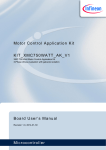

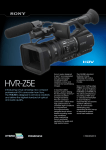

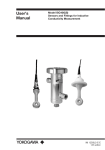
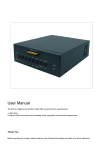
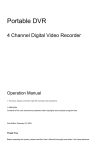
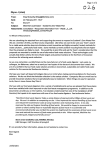
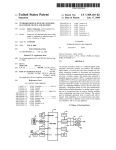

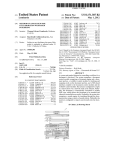
![Atari MegaST Service Manual [undated]](http://vs1.manualzilla.com/store/data/006024641_1-2bcf539c2a5a062bcc4bb84267501231-150x150.png)
